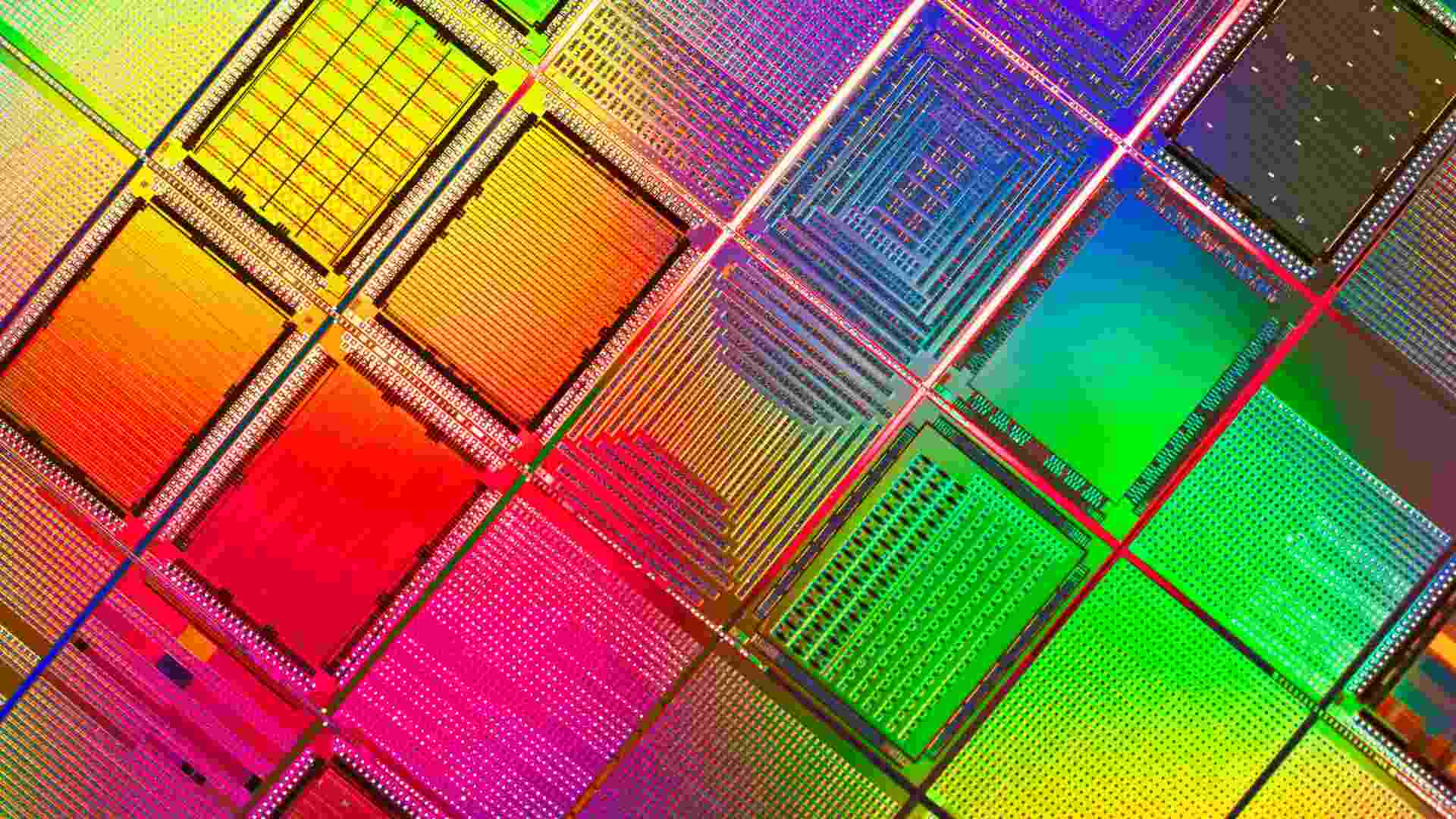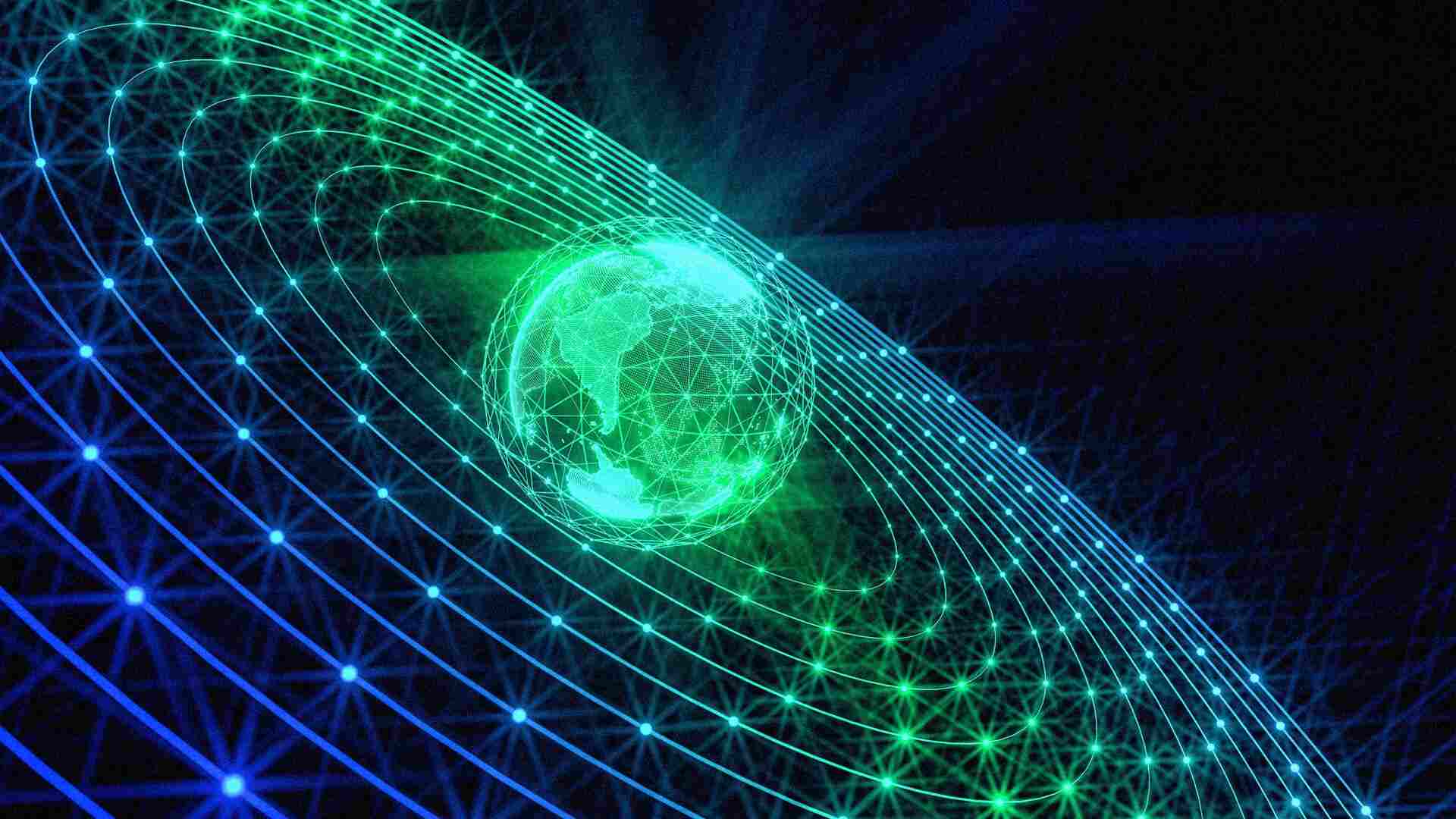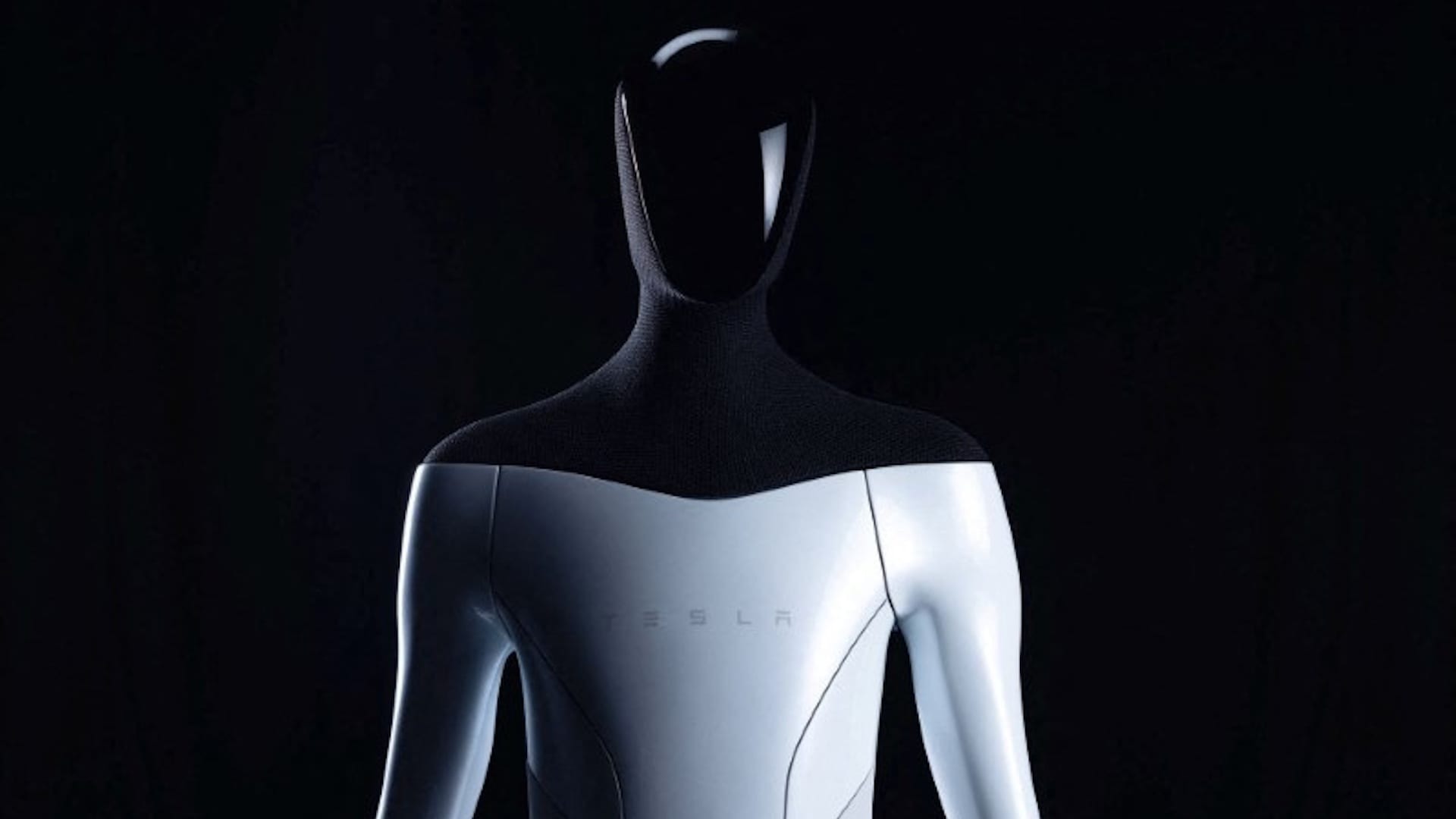- | 9:00 am
The Creativity Supply Chain is tech’s next huge opportunity
Creativity has become the focal point of our modern Internet economy. What was once just a means of artistic expression now powers much of how we all interact, work, and play online.

People are inherently creative. As far back as the history books go, humans have always expressed themselves creatively, whether for communication, storytelling, or even art. As the tools that we’ve used to express ourselves have evolved and multiplied, so too have the manifestations of our creativity.
Today, not only are the tools easy to use, they’re also increasingly powerful. Plus, we now have immediate access to a limitless ocean of others’ creative work through our powerful smartphones and a world washed in high-speed internet. This combination of ease-of-use and instant, ubiquitous access to content has unlocked the inner creativity in all of us, unleashing a massive, humanity-sized addressable market of opportunity.
CREATIVITY ≠ THE CREATOR ECONOMY
But wait, isn’t the Creator Economy dying? According to The Information, as of October 2022, venture funding for Creator Economy startups had fallen for the previous five quarters. The category, recently immortalized (and even more recently betrayed) by venture capitalists, startup founders, and tech journalists, was the promise that creators on platforms like YouTube, Instagram, and TikTok could now start making a living from their content, en masse. The Creator Economy promised to deliver not only tools to help creators make money, but ultimately, the potential for true economic independence.
Pandemic about to take your job away? No problem; the Creator Economy is here to save you from unemployment and fund your daily Instagram habit. Right?
THE CREATOR ECONOMY IS A SLIVER OF A MUCH BIGGER OPPORTUNITY
As it turns out, the constrained opportunity of the Creator Economy hasn’t lived up to its sky-high expectations. As many creators quickly learned, finding 1,000 true fans is something very few people are actually able to do. Most creators can’t break through platforms’ algorithms. Most creators are not marketing experts. Most creators are not making content that is relevant to more than a handful of people. And no, I’m sorry to say, but most creators aren’t going to benefit from their content being “ownable” on the blockchain. This is not a criticism of most creators; it’s a simple acknowledgement that the market for creators’ work follows the same power law dynamic that most other markets face.
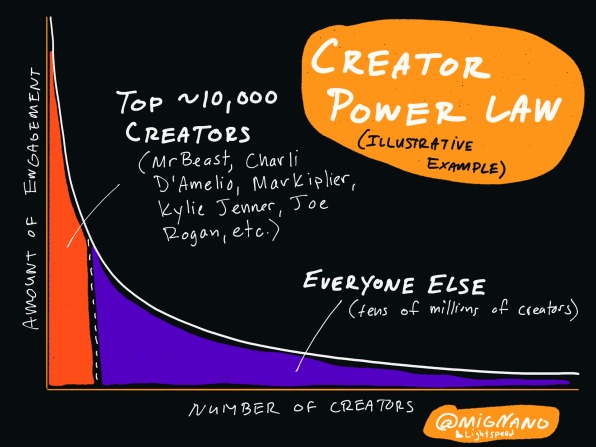
Image: courtesy of Michael Mignano
All of this is completely OK; there is nothing at all wrong with creating for the sake of creativity.
And for the few creators who can find 1,000 fans, they can no longer reliably count on their economic support in a market downturn. After all, if you lose your job and your paycheck, which expense will you choose to eliminate first: groceries, or your monthly donation to your favorite YouTuber?
In hindsight, the reasons for the failed promise seem somewhat obvious: the Creator Economy was never really meant to be a solution for 99% of the hundreds of millions (or quite possibly billions) of creators that exist today; instead, it was designed to operationalize the financial infrastructure for the top 1%–the creators who have already broken through and found demand for their work. The Creator Economy was never about democratization; it was about elitism.
THE CREATIVITY SUPPLY CHAIN
But creativity is universal. And the 99% matter. There’s arguably nothing more democratic than everyone on the planet being able to create and share their work with the world.
What if the promise of the “Creator Economy” failed because we collectively (myself included) defined the opportunity for creativity as far too small? What if we were thinking about one small piece of the market for creativity? Surely there is much more to creativity than the tools that enable the top 1% of creators to make money. What if the opportunity for creativity is much bigger than what we’ve all been calling the Creator Economy? I believe it is. I call this opportunity, The Creativity Supply Chain.
You can think of it like this:
Supply: The people that create for all purposes in today’s modern economy, and the creative media assets, which they then distribute to their audiences.
Incentives: Market mechanisms that financially and socially incentivize the creation, distribution, and consumption of creativity.
Demand: The people that consume creativity and the channels by which creative media is distributed and consumed on the internet.
Superpowers: Products, technologies, and services that democratize all forms of creative media and give us unparalleled, immediate, and ubiquitous access to creativity. Today’s cutting-edge technology both democratizes and turbocharges all of the above components, making them more accessible, efficient, and powerful. And the rate at which creative superpowers are improving is accelerating every day.
The Creativity Supply Chain is the global market for creativity in today’s modern economy. It is made up of the supply, incentives, and demand that drive how and why people create. And it rests on the technology-enabled superpowers that turbocharge all of the above, generating massive market value in the process.
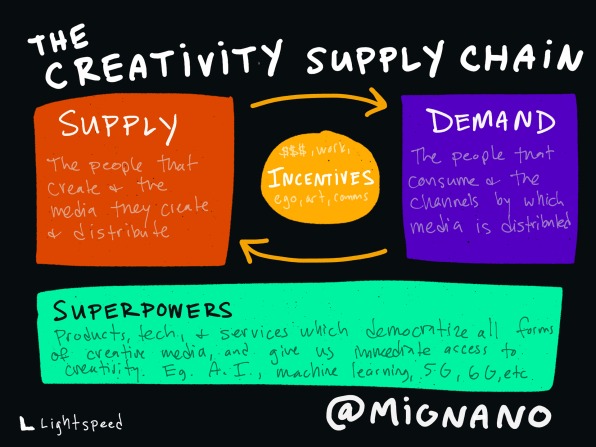
Image: courtesy of Michael Mignano
SUPPLY
I have always believed that people are inherently creative. I was raised by parents who encouraged me to pursue my many–and scattered–creative interests. I grew up playing the drums, learning to code in high school, studying computer science in college, and dabbling with music, photography, painting, and writing all along the way. As a career, my interest in creativity led me to build websites for artists at Atlantic Records and eventually build products that enabled hundreds of millions of people to take and edit photos at Aviary and Adobe. The belief that people are inherently creative was also one of the factors that led my former cofounder Nir Zicherman and me to build Anchor, a platform which democratizes podcast creation, and was acquired by Spotify in 2019.
But in 2022, I believe it should be obvious to nearly everyone that we are all creative. We write, take photos, edit videos, design presentations. We all create content using tools like our phone’s camera, Snapchat, Instagram, Facebook, TikTok, BeReal, Twitter, and YouTube. We make podcasts, webinars, short films, and crafts. We share the things we create with family, friends, our coworkers, and strangers all over the world. We spread knowledge with colleagues, partners, and prospective employers using tools like Google Docs, Coda, Photoshop, Final Cut Pro, Loom, and Descript, while sharing ideas, photos, memes from Giphy, and weekend plans with our friends and family using Pinterest, Google Photos, and WhatsApp. We’re all being creative all the time. We all create constantly, every single day.
INCENTIVES
Our incentives to be creative are varied. We create to communicate. We create for money. We create to express ourselves artistically. We create because our work requires us to do so. We create for attention; we like the feeling we get when the view count on our video starts shooting up. Sometimes we create simply to make our friends laugh.
Technology has helped streamline these incentives. Notifications buzz our phones and inboxes to let us know when others interact with our content, giving us microdoses of joy and much-needed confidence. Our teammates quickly provide feedback on work in real time using a multitude of multiplayer-enabled creative tools. For those of us looking to monetize our work, we can easily sell our audience’s attention to the highest bidder on platforms like Instagram, YouTube, or TikTok, for we are today’s version of yesterday’s magazines, television stations, and billboards. With enough distribution, a few of us are even able to get our audience to pay us directly for our work through platforms like Patreon, Substack, OnlyFans, OpenSea, Fanfic, Pietra, and more.
Regardless of our own unique incentives, we all create because there is one universal incentive which all creators share in 2022: there is overwhelming demand for creativity.
DEMAND
You are a perfect example of this demand. Think about it: How do you spend your time? You watch videos on YouTube, look at stories and photos and Reels on Instagram, get sucked into TikTok for hours at a time, interact with designs by your colleagues on Figma, laugh at memes your friends send you on Telegram, binge-watch shows on Netflix, look at friends’ baby photos on Facebook, read thoughtful essays on Substack, listen to podcasts on Spotify, scroll through beautiful websites on Chrome, read books on Kindle, scan your local news, get dinner recipes on Pinterest . . . the list goes on and on and on. You are the ultimate destination for a long list of content that once began as a spark of creativity in the mind of another person somewhere else in the world. This essay, which you are reading right now, and the hand-drawn graphics referenced throughout are all expressions of my creativity.
By this time next year, you will probably be consuming even more creativity as more products and services launch and your devices become more powerful. And while your demand for creativity continues to grow, so too does that demand for nearly everyone else on this planet; especially people who are just coming online for the first time in their lives, such as in emerging nations that are just gaining access to high-speed internet.
For every region that is nearing saturation of creativity supply and demand, there is another one just getting started on the bottom of the S-curve. We are not at the end of something; we’re at the beginning of global creative ubiquity.
SUPERPOWERS
All of the above is happening in greater volume and velocity than ever before through what I like to think of as creative superpowers. Technology has made us all more creative through better tools. It has given us the ability to more easily achieve our creative goals (whether they be financial, social, or otherwise). And it has made it possible for us to find an audience for our work, no matter where in the world we are, physically. As we consume, we become more inspired to create ourselves, fueling a virtuous cycle of creativity that spins faster and faster as technology improves.
CREATIVE TOOLS
The history of computing has proven time and time again that all forms of creativity eventually become democratized by technology. The costs of creating content are always being reduced by technology, and the abilities of people to create compelling content through technology are always increasing.
This trend began long ago (Printing press? Invention of the pencil? Rock, blood, and berry juice used to scribble on walls of caves?), but perhaps became most apparent on the internet through text and publishing of the written word. It was previously challenging for non-journalists to publish written text. But eventually, Blogger, WordPress, and ultimately Medium made it vastly easier through easy-to-use tools and one-tap publishing capabilities. Platforms like Facebook and Twitter took it a step further by simplifying the format and enabling distribution of text to people within our social networks. Now nearly everyone writes and publishes some form of content.
The same happened for photos. It was previously extremely challenging for anyone other than professional photographers to take, edit, and share photographs at scale. Then, Instagram made it possible for anyone to take and share beautiful photos with the tap of a button. Now, everyone takes and shares photos.
YouTube and TikTok did the same for videos. Anchor did the same for audio and podcasts. And the same can be said about a number of other categories. No-code website development products, platforms that enable the easy creation of video games, and even software that democratizes the creation of businesses/products are a few examples of the trend playing out in other categories. Many others will undoubtedly follow.
ARTIFICIAL INTELLIGENCE
Technology-enabled creative tools have democratized creation to the point where any of us can create with the right tools, skills, and investment of time. But artificial intelligence (AI) is taking things many steps further. AI has recently reached a new tipping point, enabling any of us to achieve incredible feats of creativity by typing a few words into a text box. Cutting edge AI models such as Stable Diffusion, OpenAI’s DALL-E, and Midjourney make it possible to create visual images of limitless possibilities, making it possible for any of us to create things we previously could only imagine within seconds.
And while today’s mainstream AI models are focused mostly on imaging, it’s only a matter of time before audio, music, video, text, and countless other creative mediums are soon disrupted by AI. Even writing code itself is in the process of being disrupted by AI. This past weekend, Nathan Baschez and the Every team introduced a product called Lex that helps writers by using AI to provide automatically generated suggestions for what to say next. Within hours, Lex had thousands of people signed up to its waiting list. It’s not hard to imagine a world in which the cost of creativity plummets as a result of the rise of AI-enabled generative media. Ten years from now, will major movie studios be investing hundreds of millions in blockbuster films? Or will a state-of-the-art AI model do all the work instead for orders of magnitude less?
UBIQUITOUS ACCESS TO ULTRA-FAST INTERNET
As of 2022, 83% of the world’s population has access to a smartphone. That means that the vast majority of us on this planet are carrying around pocket-sized supercomputers virtually everywhere we go. And here in the US, many of us now have access to 5G internet at all times. With 5G, we’re able to download or stream massive amounts of creative media to our devices virtually instantaneously. Just think about everything you are now able to do from your mobile device. You’re able to watch full-length movies with the tap of a button, access the world’s complete catalog of music, and even edit 4K video collaboratively, with your teammates, in the cloud. Ubiquitous, ultra-fast internet makes the Creativity Supply Chain hum.
And there are major tailwinds behind this superpower: 5G market penetration is only at 13% globally and it is expected to reach 64% by 2030. As more people gain access to 5G in the coming years, it’s only going to get easier to instantly perform creative tasks and consume creative media. And 6G, which will be even more powerful than 5G and make creative mediums like AR and VR more accessible, is expected to begin rolling out in the year 2030.
MACHINE LEARNING
One of the biggest breakthroughs for creativity over the past few decades has been the rise of media platforms such as Instagram, YouTube, Snapchat, Netflix, Spotify, TikTok, Twitter, Outschool, MasterClass, LinkedIn, and countless others across a variety of categories. While media platforms have traditionally relied on curated friend and interest graphs to match supply-side media with demand, platforms have recently learned that leveraging machine learning can drive far greater efficiency in distribution. As a result, media platforms across nearly every category–including social networks–are abandoning curation in exchange for recommendation media, which I wrote about extensively in a recent essay. Further advancements in machine learning and recommendation media will have massive implications on both the supply and demand sides of creativity.
For creators, finding an audience for your creativity will happen automatically upon platform distribution. We’ll upload our content, and the platform’s ML algorithms will find the perfect audience at the perfect time for our work. And on the demand side, we will instantly and easily access the exact content we want to consume with far less friction. The supply and demand flywheel of creativity will spin far faster as a result of machine learning.
THE MARKET FOR CREATIVITY
Given how quickly all sides of creativity are becoming propelled by technology, it’s clear that each and every one of us will make up the total addressable market of the Creativity Supply Chain. But make no mistake; the Creativity Supply Chain isn’t some theoretical concept from the future; it’s happening right now.
As of this writing, public companies with core businesses in the Creativity Supply Chain–such as Spotify, Shopify, Squarespace, Adobe, and Snap–represent more than $370B of market capitalization. And companies with big stakes in the Creativity Supply Chain–like Meta, Apple, Alphabet, and Netflix–represent more than $7T of market capitalization.
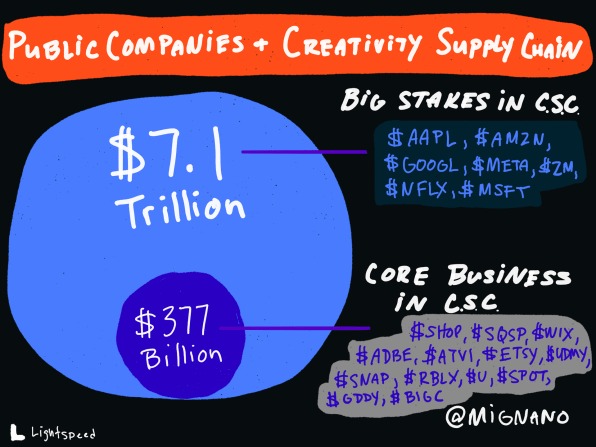
Image: courtesy of Michael Mignano
In private markets, look no further than the latest major technology acquisition–Adobe’s $20 billion acquisition of Figma, the largest ever acquisition of a venture-backed company–for proof that there is massive demand for companies contributing to the Creativity Supply Chain.
And Canva, a company that makes it easy for anyone to create beautiful images and graphics for both professional and personal use cases, recently topped 100M monthly active users and is reported to be generating more than $1B in annual revenue.
The demand for Creativity Supply Chain businesses will only increase. As we all spend more of our time creating and consuming, and more of our personal and professional lives become transformed by technology, creativity will be even more entrenched in nearly everything we do on a daily basis.
CREATIVITY ISN’T FLEETING. CREATIVITY IS FOREVER
You can’t contain or limit the potential of creativity to specific incentives, such as the monetization of one’s top 1,000 fans. Yes, there will always be financial markets built around monetizing the work of top creators. But the reasons why people create are far more universal and fundamental to our common humanity, and these reasons result in a tremendous amount of aggregate value. And this is why the opportunity for creativity will continue to grow and flourish in lock step with technology. I like to imagine that today’s creative tools are the ones Steve Jobs was dreaming of when he first called computing a bicycle for the mind.
Everyone is creative. Technology increasingly fuels our collective ability to create, the incentives that motivate us to create, and our insatiable demand for the things others create. And through recent technological breakthroughs in artificial intelligence, machine learning, and high-speed internet access, the market for creativity is destined to reach new heights in the coming years and decades.
What do you think? Is creativity becoming the central driving force behind our modern Internet economy? And what’s next for the technology that powers the Creativity Supply Chain? If you’re working in this space or have feedback on this essay, shoot me an email or reach out to me on Twitter or LinkedIn.











